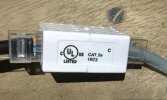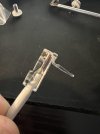- Messages
- 106
- Points
- 18
Hello, I am reasonably proficient in mechanical things but I have an annoying problem with a PTZ camera and I need some very basic help if possible please. Firstly, let me say that there is nothing wrong with the camera itself, when I can get it to work it works well. I am convinced that it is a cable problem, or rather a connector on the cable run. We keep losing the camera on the NVR but when I climb up into the attic and play with the connector most times the camera starts to show again. I have attached an image of the connector and in my World I have never come across such a complicated cable. It looks like there are lots of individual wires that go to make up the cables and my thoughts are that if it is reasonably easy to get a new connector and replace the existing one then it will save wasting time of the installers.
I know it will be a very basic question and I really would appreciate being told a, what type of connector it is and b, a pointer on how to use it, i.e. a YouTube video or something lke that. Thanks to anyone who will help.
I know it will be a very basic question and I really would appreciate being told a, what type of connector it is and b, a pointer on how to use it, i.e. a YouTube video or something lke that. Thanks to anyone who will help.




